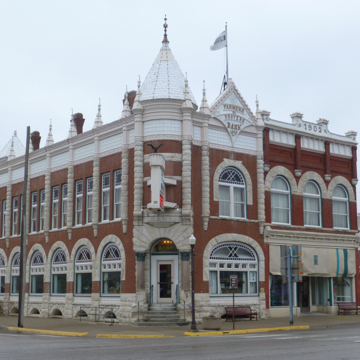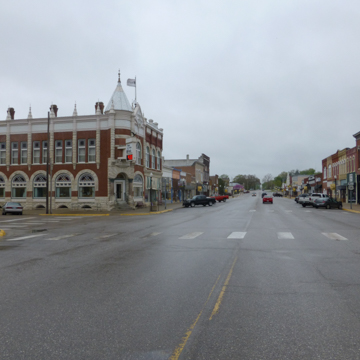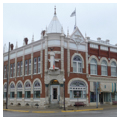The Farmers and Drovers Bank in Council Grove is a particularly well-designed example of a building type that can be found in many Kansan small communities: the corner bank building. It is also an effective symbol of a young city’s active business culture, signaling the importance of the bank in the civic, as well as physical, environment of the town.
The Farmers and Drovers Bank was established in 1882 after W. H. White was robbed on his return from selling cattle. Seeing the need for a secure place to hold funds, White gathered the support of his fellow farmers and ranchers and opened a bank. By 1887 White purchased a lot on the southwest corner of Council Grove’s most prominent intersection and secured the services of the Emporia-based architect Charles W. Squires (1851–1934) to build a permanent home for the bank. Squires designed a robust, eclectic, red brick building trimmed with limestone lintels and pressed metal cornice details. Like many buildings of the type, it features a prominent corner entry and generous windows on each of two levels.
An economic downturn delayed construction until 1892, when local craftsmen resumed work on the building. As was the case with many buildings of this type, in addition to space for bank operations, the building offered rental space to other mercantile and professional businesses. When the building opened on March 3, 1893, spaces had been leased by two dentists, a law firm, the local newspaper, and a cafe.
In 1901, the Bank secured the adjacent lot and began construction on a building designed to complement the original structure. The new building, known as the Indicator Building, included storage space for the bank and an area for a grocery store on the first floor. The second floor was initially rented to an insurance company, but when this tenant left, an outside stair was constructed, and the space was offered as a venue for civic, educational, fraternal, and religious events. The lower portion of the primary facade has since been altered.
Five generations of the White family have operated the bank, and have continued to support community causes. The interior of the buildings have been renovated a number of times through the years to accommodate the growth of the banking business. While little remains of the original interiors, the White family has been a good steward of the buildings. The exterior has been carefully maintained, and interior changes have tried to be mindful of historic details, even as they updated the facilities.
NOTE: This entry was originally published in David Sachs and George Ehrlich, Guide to Kansas Architecture (Lawrence: University Press of Kansas, 1996). © 1996 by the University Press of Kansas.
References
Wortman, Julie A., “Farmers and Drovers Bank,” Morris County, Kansas. National Register of Historic Places Inventory–Nomination Form, 1980. National Park Service, U.S. Department of the Interior, Washington, D.C.









